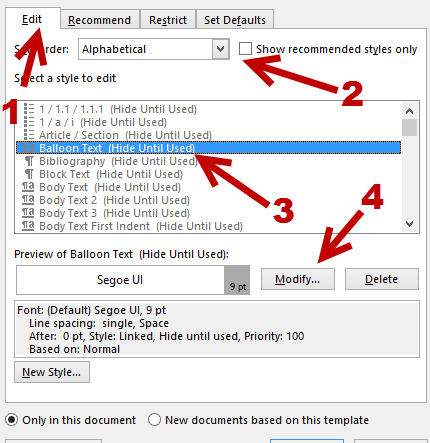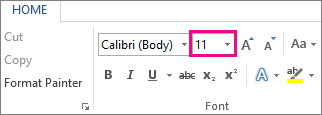

- MICROSOFT WORD 2016 FOR MAC NEW COMMENT CHANGING FONT SIZE UPDATE
- MICROSOFT WORD 2016 FOR MAC NEW COMMENT CHANGING FONT SIZE SOFTWARE
- MICROSOFT WORD 2016 FOR MAC NEW COMMENT CHANGING FONT SIZE FREE
- MICROSOFT WORD 2016 FOR MAC NEW COMMENT CHANGING FONT SIZE WINDOWS
Although we're glad that Microsoft offers free converters, we find the forced extra steps annoying in Office 2007.
MICROSOFT WORD 2016 FOR MAC NEW COMMENT CHANGING FONT SIZE SOFTWARE
That means for now, should you save work in a new OOXML format in a hurry, someone with the older software won't be able to open it. Free file conversion tools won't be available until as long as 10 weeks from now, or 8 weeks after the applications are available in stores. We're not thrilled about this being the default option, even though you can save your work in the older DOC, XLS and PPT formats. Office for Mac saves work in the same, new Open XML formats used by Office 2007 for Windows. Being accustomed to Office for Windows, we'd rather find all these options at the top of the screen. For simple tweaks such as changing fonts, you'll need to consult floating formatting boxes. We found the shape-shifting neither terribly distracting nor useful. Office for Mac lacks the Ribbon, but some menu items appear only in step with the task at hand.
MICROSOFT WORD 2016 FOR MAC NEW COMMENT CHANGING FONT SIZE WINDOWS
Office 2007 for Windows clusters functions within a contextual "Ribbon" toolbar that displays different options. This is handy if you rely on Entourage but don't want to run it all the time. The new My Day widget for Entourage floats on the Mac desktop displaying calendar items and to-do lists. Now you can save to PDF, and Automator actions are supported. There are more welcome and substantial changes as well. These are premade templates with 3D and translucent designs. For instance, Office for Mac features the same templates and Smart Art graphics as the Windows counterparts. The 2007 applications for Windows arrange functions within tabs, while the 2008 Mac software largely clusters functions within the same drop-down menus including File, Edit, and View.īy and large, most of the changes focus on attempting to help users craft more attractive documents. That's good news for anyone who doesn't want to relearn the locations of common functions. Unlike Microsoft Office 2007, the interface changes don't look radically foreign next to the 2004 edition. There's no Microsoft Access database application for the Mac, although Filemaker's upcoming release of Bento offers Mac users a new choice. Office for Mac includes Word, Excel for spreadsheets, PowerPoint for presentations and Entourage for e-mail and time management.
MICROSOFT WORD 2016 FOR MAC NEW COMMENT CHANGING FONT SIZE UPDATE
One your apps have loaded, quit your Microsoft Office apps and relaunch them a second time to see your updated fonts list.Microsoft Office for Mac 2008 may be the best pick for business users, with major updates to Word, Excel, PowerPoint, and Entourage.Īfter a series of delays, Microsoft plans to release Office for Mac 2008 to brick-and-mortar and online stores on January 15, making this the first update in nearly four years. defaults write PrioritizedFonts -array "Helvetica-Light" "Helvetica" "Helvetica-LightOblique" "TimesNewRomanPSMT" Postscript names here are case-sensitive and must match exactly what Font Book.app provides.

Type the command ' defaults write PrioritizedFonts -array "postscript name 1" "postscript name 2" "etc."’ and hit return to run it. Select the font you want to prioritize in the center paneĮnsure Font Information is selected in the top left of the window, and find the PostScript Name field in the right pane and copy it. Launch Font Book (open applications folder in Finder, find and launch "Font book.app") Note: Postscript names are not the same as font families and each style will have a different postscript name, so to prioritize an entire font family you may need to add multiple names.

You can work around this by setting the fonts you need that do not appear as prioritized fonts. This causes some fonts not to appear in the font picker. If you have a large number of fonts installed on your system, Microsoft Office apps may not be able to load all the fonts. If you have a single version of font, check the font type. If the font type is displayed as “PostScript-Type1”, we recommend you upgrade it to a newer "OpenType" version of the font. Some fonts may be missing."Ĭheck the installed versions of the font. If you have multiple versions, then make sure the latest version of the font is active. You may see a message bar saying "We were unable to load all your fonts. Some fonts are being substituted with other fonts. Some fonts including Times New Roman are missing or unavailable in the font picker. Text appears garbled or in a different font. Users may see issues with fonts when using version 16.9 of Microsoft Word, Excel, Outlook, OneNote and Microsoft PowerPoint on macOS.


 0 kommentar(er)
0 kommentar(er)
